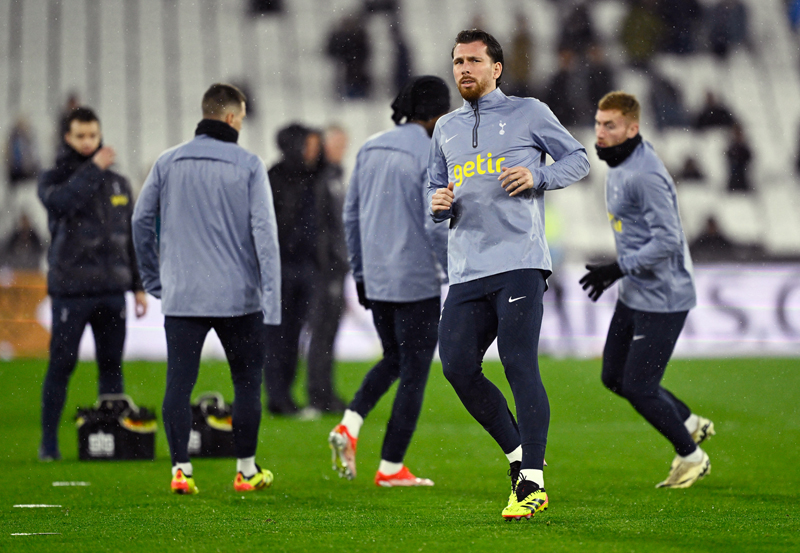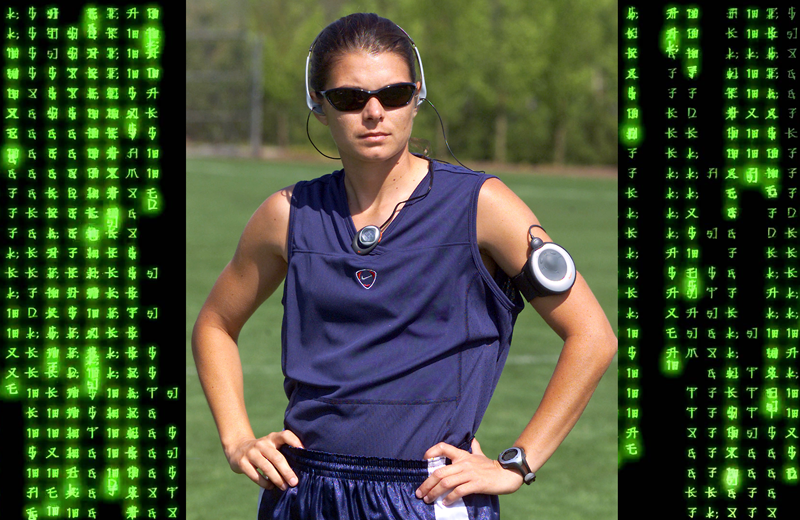You are viewing 1 of your 1 free articles. For unlimited access take a risk-free trial
Stop the monkey business if you want to race strong!
Josie Perry explains the theory of the neuroscience of threat in terms of the ’chimp’ model, how our responses can negatively affect sports performance and how to tame the chimp in your head to race better
Josie Perry explains how to tame the chimp in your head and race better
When we lose our cool in endurance sports it may not be immediately obvious. We don’t have racquets to throw like tennis players or referees to yell at like footballers. Instead, we may swear to ourselves, race angrily or simply pull out. The temper tantrum sabotages our race but we feel hostage to it, as though we have been taken over by something illogical and irrational. And it’s true - we have been taken over by our chimp.
Our chimp is a part of us - a vital part of our brain. But it’s also a part that can hold us back when we race. Psychiatrist Steve Peters created the Chimp philosophy (see chimpmanagement.com/) as a way to explain the neuroscience behind our responses to threat. He has used it with numerous athletes including the GB Cycling team. As a sport psychologist, I have found it to be a really helpful way of explaining a complex process so athletes can understand how the different parts of our brains work, especially when they feel emotional.
The model highlights how we have three key areas in our brains which are used in emotional regulation and decision making, all with different needs. Peters labels them as the ‘human brain’, the ‘chimp brain’ and the ‘computer brain’. The theory is that once we understand how each part of our brain works, what their agendas are and why they act as they do, we can then work with them to create more positive behaviours.
Meet your chimp, your human and your computer
Your chimp, sitting in the limbic region of your brain (see figure 1), is emotional and impulsive. It follows instinct, is hyperactive, has no patience, jumps to conclusions, can get paranoid and is often irrational. It makes quick decisions based not on logic or facts but on thoughts and feelings. If we are in genuine physical danger they can push helpful actions (such as running away from dangerous situations). However, if it is only our ego which feels threatened, the decisions are often poor ones, putting us into a self-destruct mode.
Chimpanzees have been described as having a ‘jungle mentality’, going quickly into flight, fight or freeze mode whenever they senses change or danger. The chimp mentality is full of self-doubt and fear and will do all it can to survive, however much chaos it causes in the process. We need our chimp. In genuinely threatening situations, it is a fantastic early warning safety system. But, in order to be better athletes, we need to be able to tame it.
The ‘human brain’ is the rational, analytical part of the brain, which processes information in a considered way. Physiologically, the region of the brain that undertakes this processing is primarily the pre-frontal cortex (figure 1). The human brain searches for facts and context so it can make decisions based on logic. It does so with the aim of building good relationships and making long term plans, because it understands consequences. The human and chimp work alongside each other and often battle for dominance. Unfortunately, the chimp works five times faster than the human so it will often win!
Figure 1: The pre-frontal cortex and limbic regions of the brain

The third element is the ‘computer’ in the parietal region of your brain. This works as a storage library for memories, values, automatic behaviours, experiences and habits so we can use them for future reference. It can think and act automatically for you by using pre-programmed thoughts and behaviours. The pre-programmed behaviours are driven by ‘autopilots’ (positive, constructive automatic beliefs, behaviours), ‘goblins’ (hardwired and pretty permanent), ‘gremlins’ (unhelpful or unrealistic expectations but can be changed), your ‘stone of life’ (your core beliefs, your values and your view on what life is about) and your mindset (how you perceive yourself, other people, and the world around you). Your computer is faster than both your human and chimp so whoever controls this gets to do the thinking and dictates which part of the computer will be referenced. If it is the human then autopilots are used a lot. If it’s the chimp then goblins and gremlins rule.
Who’s in charge?
Day to day, our computer is in charge. This is essential as we have to make around 30,000 decisions a day (no-one has actually counted, but this is the best guesstimate) so they need to be made automatically, through habits, without conscious thought. When something threatens us though; either physically or mentally, our emotions get ignited and our chimp leaps into action. When we compete in sport, we may not be physically under threat, but our ego may well be. We fear we will be judged for poor performance, beaten by someone ranked lower than us or we may miss our goal. And the more our self-identity is built around our sport, the more our ego is at risk.
Case study: Robbie Britton

Robbie Britton, the Chamonix-based GB ultra-runner has thought deeply about the ‘chimp’. He reflected after his very first DNF and realised that his chimp had been in charge during his race. As he explained: “In the UTMB a few years ago, I was too emotional. It was the first time I didn’t finish a race. I let my base emotions overtake me. At the time the race was the biggest thing in the world to me. I’d moved house to train for it and I got too carried away with it all. That DNF was a really good point for self-reflection for me. One of the things I reflected on was the emotion and how it had tripped me up.”
Now Britton is much more careful about using his chimp as a strength, only letting it come out to play in the final stages of a race, where less can go wrong and where he can use it to improve his placing in relative safety. “I am an emotional runner but now I know it has to be portioned out over a race. I have to control it and hold back till I get to a place where it is safe to let go. My chimp now comes out at the latter stages of a race but to me it feels like a strength.” He used this tactic to great success in the 2015 24-hour World championships. “I waited till the last hour to let my emotions escape. I was imagining being on the podium. It was dragging me forward. My final marathon in that race was 3:20, my fastest marathon of the race and I came third overall. So now I see my strength as the emotional side at the end of a race, letting me struggle a bit better than everyone else.”
Britton learnt to control his chimp in the same way he’s honed his skills to run efficiently or stay upright running down mountains; reflecting, becoming self-aware, adapting and utilising it as a strength. We can all learn to do this too, with dedicated focus and some specific tactics.
Strategies to take control
*Name your chimp
To take control, the first strategy is to be really self-aware. When we feel stressed or under pressure, it is helpful to ask ourselves which part of our brain is likely to be in charge. If we know how our behaviours change when our chimp comes out we can question whether we are thinking rationally, whether we want to feel like this and will we still be thinking this way tomorrow when we are calmer. A key step to achieve this is naming your chimp. It helps it feel more tangible and easier to control. Lots of athletes like to use variants of their own name. My computer is Josephine. My human is Josie. My chimp is Jo.
*Clean up your computer
If we work hard to understand our stone of life (our own truths, values and life force) then it is easier to manage our chimp and set more helpful autopilots. Think of it as the hard drive for your computer. If we really understand our values and our beliefs, it is easier to keep these in mind when our chimp is advocating something which contradicts them. Some time spent reflecting on what matters to us is time well spent.
*Load up positive references in your computer
Once you become skilled at recognising that your chimp might be coming out to play, you can put in place actions to control it. Under threat, our chimp and human work alongside each other but the chimp’s emotional response is stronger and faster. However, as the chimp checks the computer for reference, if we fill our computer with automatic responses - positive habits which can be actioned automatically, rather than negative gremlins or goblins - then we can make sure we still get the result we want.
*Shout over the chimp
The Chimp constantly seeks security. For many of us however, part of the appeal of endurance racing is not knowing how far we can push ourselves. Our human brain is okay with this but our chimp brain hates it and will want to remove the risk. We can use the data in the computer to remind the chimp we have been in this situation before (other races) and survived. Recounting these regularly and continually adding more positive experiences boosts their power, and helps the memories come out automatically. If you do not have this response on autopilot, you will need to tell yourself over and over again to drown out our chimp’s voice and replace it with your human logic.
*Feed your chimp a banana
Finally, while it can be very hard to stop your chimp coming out to play, you don’t have to be hijacked by it because you can choose not to follow its advice. A helpful way to do this is to soothe the chimp by giving it a little bit of security to feel less attacked. Think of it like giving it a banana. Then when your chimp wants you to react illogically, you can guide it towards more productive behaviour by offering a reward. This might be self praise. It might be approval. Another way of ignoring the chimp is to undertake extensive preparation or mentally condition yourself to expect that the event you are doing is supposed to be hard. This slows down the initial chimp response so a more logical ‘human’ behaviour comes out rather than the irrational rant of a chimp!
Newsletter Sign Up
Testimonials
Dr. Alexandra Fandetti-Robin, Back & Body Chiropractic
Elspeth Cowell MSCh DpodM SRCh HCPC reg
William Hunter, Nuffield Health
Newsletter Sign Up
Coaches Testimonials
Dr. Alexandra Fandetti-Robin, Back & Body Chiropractic
Elspeth Cowell MSCh DpodM SRCh HCPC reg
William Hunter, Nuffield Health
Keep up with latest sports science research and apply it to maximize performance
Today you have the chance to join a group of athletes, and sports coaches/trainers who all have something special in common...
They use the latest research to improve performance for themselves and their clients - both athletes and sports teams - with help from global specialists in the fields of sports science, sports medicine and sports psychology.
They do this by reading Sports Performance Bulletin, an easy-to-digest but serious-minded journal dedicated to high performance sports. SPB offers a wealth of information and insight into the latest research, in an easily-accessible and understood format, along with a wealth of practical recommendations.
*includes 3 coaching manuals
Get Inspired
All the latest techniques and approaches
Sports Performance Bulletin helps dedicated endurance athletes improve their performance. Sense-checking the latest sports science research, and sourcing evidence and case studies to support findings, Sports Performance Bulletin turns proven insights into easily digestible practical advice. Supporting athletes, coaches and professionals who wish to ensure their guidance and programmes are kept right up to date and based on credible science.














